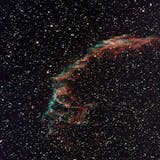The Vespera Dual Band Filter is a dual narrowband interference filter that will significantly improve your photo quality whether you are viewing from an urban or natural environment.
By selecting very precisely the wavelengths of Hydrogen Alpha (H-alpha) and Oxygen III (O-III), found mainly in nebulae, the filter will increase the contrast between the Stellar object and the sky background. Thus, its use makes it possible to obtain a higher-quality image, with sharper stars and finer details.
Keep only the essential
The Dual Band filter has been designed to allow only two particular wavelengths to pass through to the Vespera sensor:
- O-III
- H-alpha
Due to the filtered wavelengths, it is particularly effective for photographing nebulae in emission (e.g.: Orion nebula M42, Heart nebula IC 1805 …), dark nebulae endowed with hydrogen (e.g.: Horsehead or Elephant's Trunk nebula...), planetary nebulae (e.g.: Owl nebula M97, Dumbbell nebula M27...), supernova remnants (e.g.: Veil nebula, Crab Nebula M1...).
For globular clusters (e.g.: Hercules cluster M13, cluster M92...), the selectivity of the Dual Band filter will help you to obtain sharper stars.
A filter specifically studied for Vespera
The optical quality of the Dual Band filter has been specifically studied by our engineers to offer use at full aperture, without any impact on the optical diameter of the instrument. The lens ring is equipped with an electronic micro-card that allows Vespera to detect the Dual Band filter and adapt its observation and image processing parameters.
Transmission curve
The filter features 12nm of bandwidth in each wavelength (O-III = 500.7nm, H-alpha = 656.3nm).








